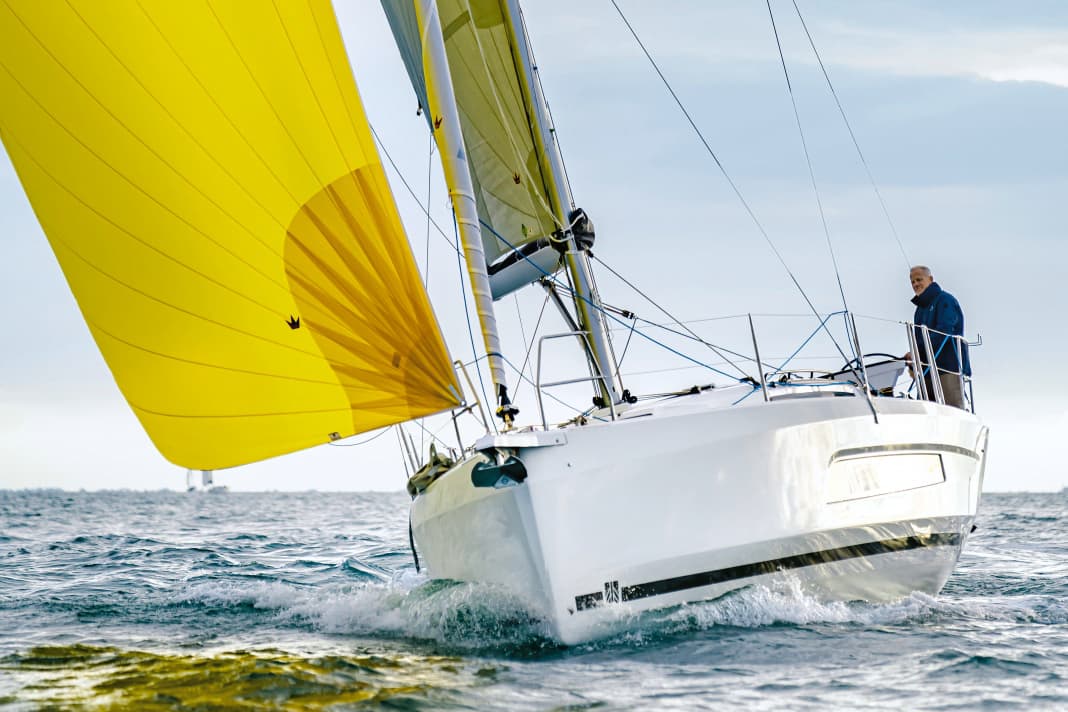





Dufour has undergone several transformations over the past decades - and yet has always remained true to itself. Will it be able to do so again now that the model range has been renewed? And with this boat, which is called and sounds like an eleven-metre yacht, but whose hull measures only 9.99 metres, which even the shipyard now considers to be a little too much marketing?
Well, there is one constant: The latest new development, like the three generations before it, also comes from the studio of Italian yacht designer Umberto Felci. And despite its focus on comfortable cruising, it also has a sporty feel. With her hull tapered towards the deck and the chine edges above the waterline, she borrows stylistically from modern ocean-going yachts such as the Class 40 or Imoca 60.
For its length, however, the Dufour, which we frankly find difficult to name 37, is surprisingly wide - wider than any of its direct competitors. The effect is most obvious in the full foredeck, which quickly becomes fuller from the stem. Nevertheless, Umberto Felci has managed to skilfully conceal the weight. To this end, he has integrated a characteristic, noticeably rising window strip in the centre of the hull, which lies in a corrugation and, together with the chines, visually stretches the high freeboard - and also makes the boat identifiable from a distance. However, the black strip conceals only one usually wide window on each side - the vast majority of the rest is merely a stylistic device.
Lying on the jetty or at sea, the ship does indeed appear more impressive due to its characteristic lines, even larger than the 32.7 feet it is actually long. This means that it only towers over its little sister, the Dufour 32, which was presented last year, by two feet or 64 centimetres. Nicolas Bérenger, the senior product manager, doesn't beat about the bush: "The 37 is misleading, we are aware of that. "Because the yacht offers so much more living space than the 32 and its predecessor, the Dufour 352, we have chosen a model name that most closely reflects the feeling of space."
This approach is certainly open to debate, especially as the price of the new models is likely to have played a role in the decision, which is a far cry from the usual. We'll come back to this in a moment. But one thing cannot be denied: Thanks to the skilful design of the interior fittings and the many deck and side windows, the shipyard has indeed succeeded in creating a spaciousness and width previously unknown in this class.
The Dufour 37 in detail:
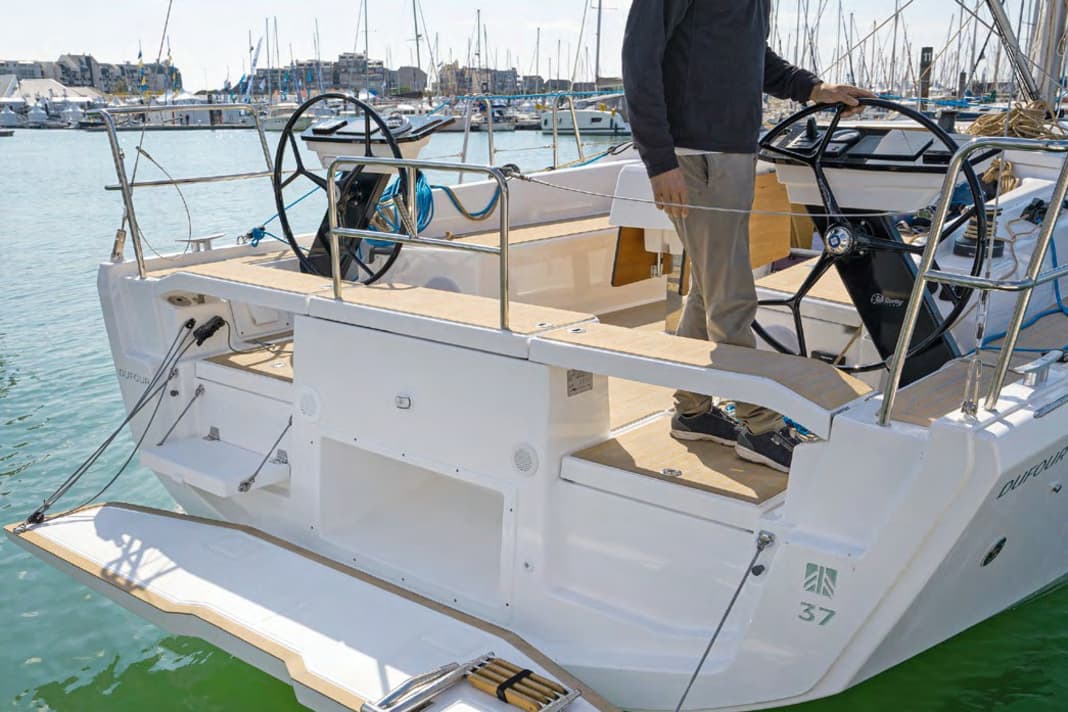





Dufour offers three equipment variants for the new model: The "Easy" version is primarily intended as a charter boat, has a self-tacking jib and only two winches in the cockpit, which are also small in size.
As an "Ocean" (surcharge: €5,950), the boat has a genoa with centre of gravity adjustment via buoys, two additional winches on the cockpit coaming and is prepared for an asymmetric spinnaker.
The Performance version (€10,710 extra) comes with a black-painted rig and a total of six winches, some of which are one size larger. The mainsheet is no longer operated on the superstructure, but is attached to the cockpit floor, from where it leads to the boom jib, in front of the mast and back to the cockpit on both sides. The boat is also equipped with a trimmable backstay, a smaller cockpit table and Dyneema reeling lines.
No matter what you choose, the Dufour offers plenty of space on deck. Her cockpit is located as far aft as possible and very far out, which provides more space. Here too, no rival currently offers more. However, you have to make compromises here and there. The seating position on the cockpit benches is very low (38.5 centimetres), as is the working height of the winches on the companionway (88 centimetres). In addition, the distance between the steering wheel and the folding seats was too short for the helmsmen at 37 centimetres; when steering while standing, you can feel the benches on your calf. However, the cockpit benches themselves are well dimensioned.
Storage space in the cockpit is tight due to the large and spacious aft cabins. There is only one shallow locker on the starboard side that reaches up to the hull wall (capacity: 460 litres) and another in the footwell of the helm station on the same side, which holds a good cubic metre.
It is difficult to access because the bench seat has to be folded aside first. The floor hatch also opens forwards, making it difficult to access from the cockpit; you have to reach over the lid. An attachment point on the side or aft would be better, as you can only reach the stowage items easily from the short but adequate bathing platform. The gas-fuelled plancha grill, which is becoming increasingly popular, can also be operated from here.
Below deck: plenty of space, but no navigation table
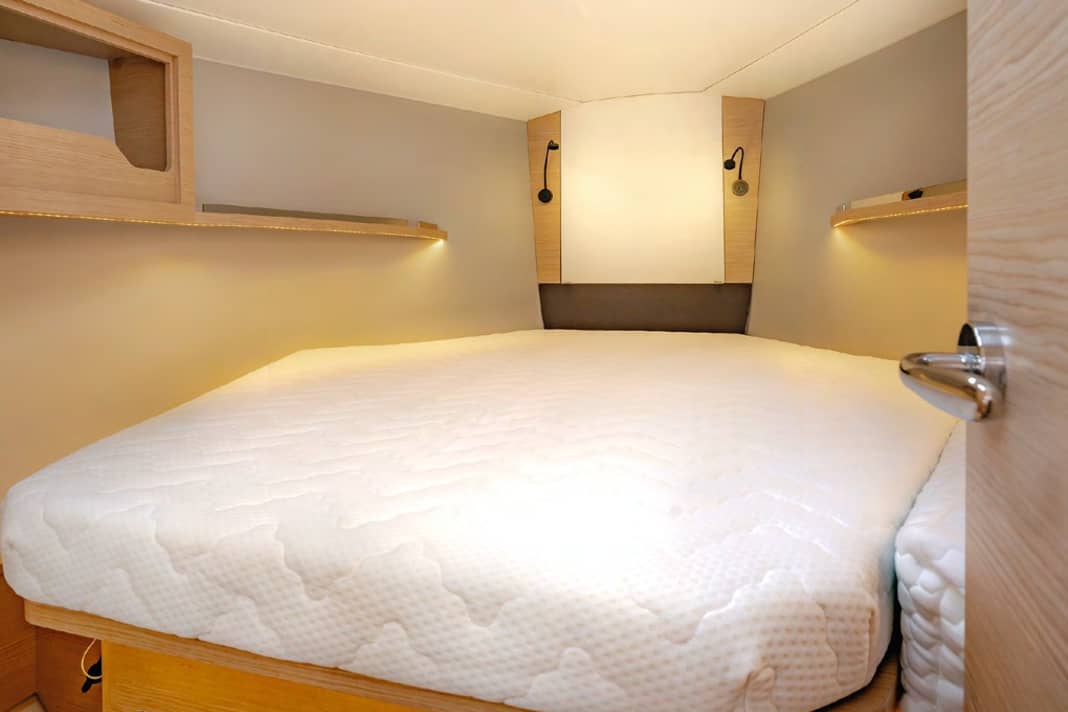





The way forwards is safe thanks to the relatively wide side decks. There is a large deck area on the foredeck in front of the superstructure, which is ideal for sunbathing, but also offers enough space for a dinghy. What is clearly missing is a hatch to the anchor locker, which is very compact and can only be reached via an inspection hatch in the owner's cabin in case the winch goes on strike or the chain gets caught.
The arrangement of the fittings and winches looks harmonious. Only the lever clamps on the cockpit coaming could be mounted closer to the winches so that the helmsman can also operate them. Unusual: The mast standing on deck was extremely pre-stressed over the upper shrouds and bent aft in an almost banana shape - actually a strong wind trim. However, the Dufour was extremely lively in this configuration in light and medium winds. Unfortunately, the backstay cannot be adjusted in the ocean version; it is fixed.
In the harbour and under engine, the Dufour has very good manoeuvrability thanks to its single rudder blade. And even under sail, she responds directly to steering commands and conveys a lot of feeling via the rudder. During the test off La Rochelle, the wind only blew at ten to twelve knots on the first day; nevertheless, the pressure was sufficient for very acceptable values. Upwind, the boat logged 5.6 to 6.1 knots, and when dropping onto a sharp room sheet course, 7.5 to 8.4 knots were recorded under gennaker.
When the wind picks up to 16 knots the following day, the Dufour shows her true potential and constantly runs between eight and nine knots on the beam, which is more than her theoretical hull speed. At cruising speed, she averages 6.5 knots with a tacking angle of around 90 degrees. In all manoeuvres, the Dufour is very balanced on the helm and enters the wave smoothly at the cross. A good performance overall.
Anyone who buys a boat of this size more for its secondary virtues, i.e. living comfort, will not be disappointed either. Within the limits of what is physically possible, the Dufour is a real space miracle. A deck strut directly in front of the sliding hatch reduces the headroom when going below deck. Once there, however, the light wood and the light grey upholstery and work surfaces in combination with the large deck and side windows make the yacht look extremely inviting. The double-leaf door to the foredeck further enlarges the living space. Indirect LED lighting extends this effect into the evening hours.
Dufour 37: What still needs to be improved?
On request, the boat has a total of six berths in three cabins plus two in the saloon. Those who forego the second aft cabin gain more space in the wet room and in the starboard locker. There is plenty of storage space under the berths and in the lockers above, although the locker doors open upwards and are therefore not seaworthy when the boat is in position. The shipyard has chosen a hexagonal mattress in the foredeck, which is sufficient with a maximum width of 1.58 metres. In addition, there are insertable triangular cushions; they widen the lying area at the head end to a princely 2.37 metres. In contrast to the foredeck, the aft cabins appear gloomy and poorly ventilated, but the shipyard intends to make improvements here and install additional windows to the cockpit. The berth size of 2.02 by 1.50 metres is more than adequate.
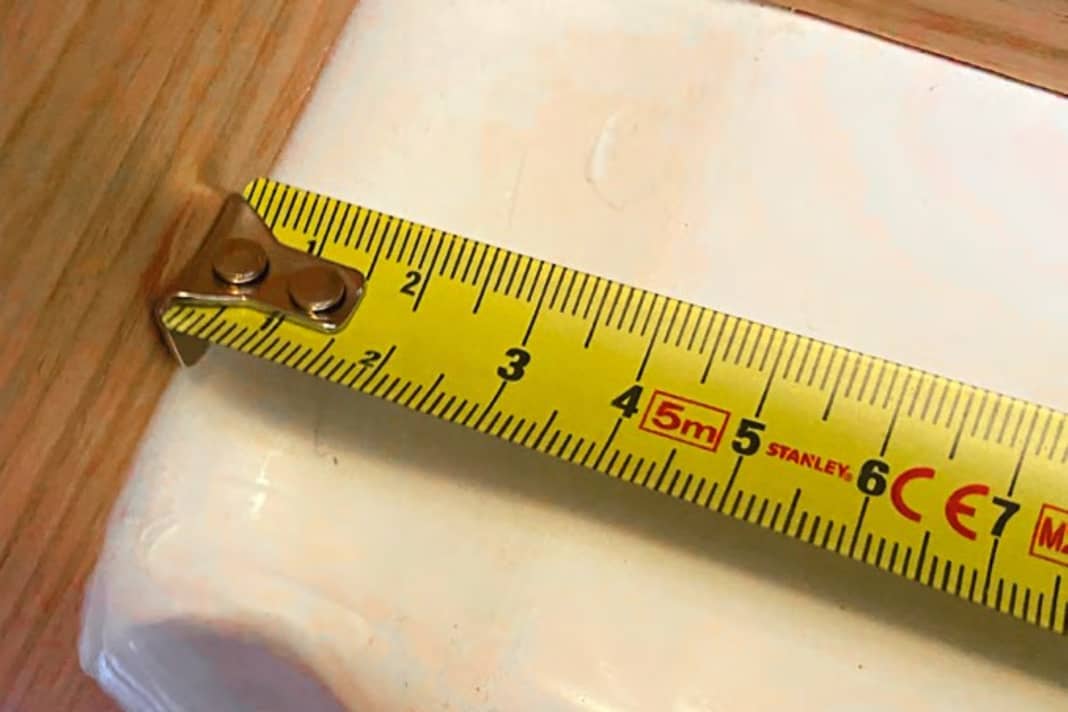




What was not entirely convincing was the attention to detail (see above). The shipyard is aware of the shortcomings and promises improvements. This is also necessary, as the Dufour 37 is not really cheap, even in the simplest version. For the "Easy", which is far from fully equipped, 185,000 euros are already due. For the "Ocean" it is a hefty 208,675 euros ready to sail. The test boat with almost all the extras even costs more than 310,000 euros. The latest price increases for raw materials and energy are already having a full impact.
Is it worth it? That depends not least on individual requirements and budgets. There are ten-metre boats for considerably less money. However, none offer as much space, as much light, as modern a design as the Dufour 37 and none offer more sailing fun. This would be even more true if it were called the Dufour 33.
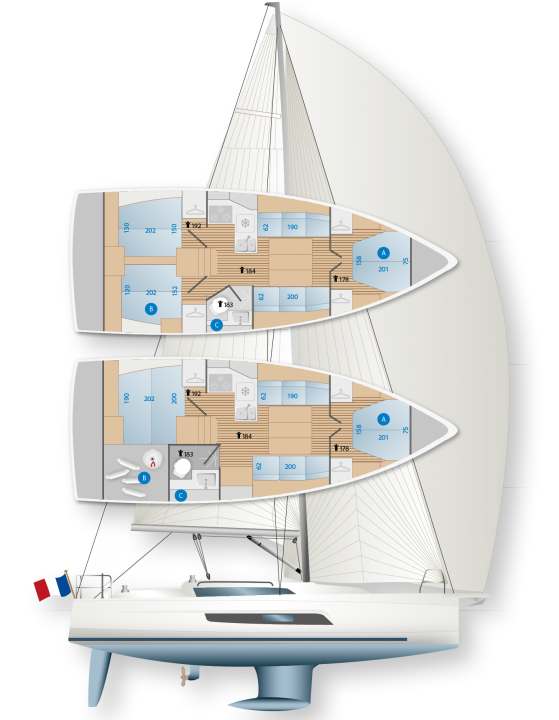
Technical data
- CE design category A
- Hull length 9.99 m
- Total length 10.77 m
- Waterline length 9.31 m
- Width 3.80 m
- Draught 1.90 m
- Theoretical hull speed 7.4 knots
- Weight 6.5 tonnes
- Ballast/proportion 1.86 t/29 %
- Mainsail 32.0 m²
- Furling genoa (108 %) 25.9 m²
- Engine (Volvo Penta)14 kW/19 hp
- Fuel tank 160 litres
- Fresh water tanks 180 litres
- Holding tank 40 litres
- Batteries 2x 120 Ah + 1x 75 Ah
Sailing performance
without drift/current; wind speed: 10 to 12 kn (3-4 Bft), wave height: approx. 0.5 m
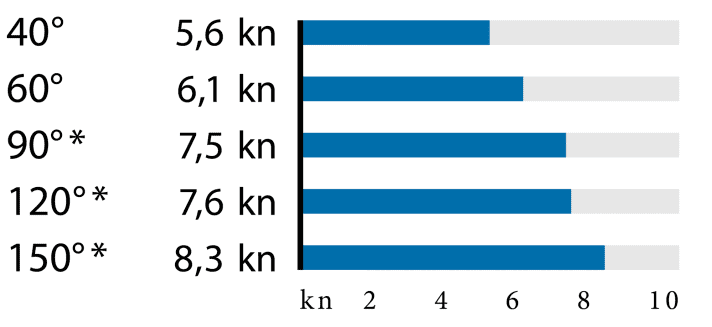
Potential STZ* = 4.06

The Dufour 37 has little sail area for its displacement, but converts this efficiently into speed.
Hull and deck construction
- Hull: GRP full laminate
- Deck: GRP sandwich with foam core. Structural floor assembly laminated to the hull
Rig and sail
- the boat has two upper and lower shrouds in the base
- no backstay adjustment
- a self-tacking jib
Motorisation
- The standard engine has an output of 19 hp, which is a small figure considering the displacement. The upgrade to 30 hp costs 2,260 euros and is well worth it. The engine ran reasonably quietly in the test. Unfortunately, noise measurements were not possible
Cockpit dimensions

Equipment and prices
- Base price ex shipyard € 185,640
- Price ready to sail € 208,675
- Comfort price € 250,808
- Warranty/against osmosis 5/2 years
Shipyard
- Dufour Yachts
- 17180 Périgny (France)
- www.dufour-yachts.com
Yacht Rating Dufour 37
With great consistency in the hull design, the shipyard has succeeded in building a real spaceship that still has good sailing characteristics. It not only appears larger than it is, but also looks very striking from every perspective. However, Dufour has paid dearly for the extra space and modernity
Design and concept
- + Space below deck
- + Visually appealing design
- - Confusing type designation
- - High price
Sailing performance and trim
- + Good height and speed
- + Simple handling
- - Balanced on the rudder on any course
Living and finishing quality
- + Very bright, spacious lounge
- - Dark aft cabin with poor ventilation
- - Satisfactory finishing quality, lack of wobble bars
Equipment and technology
- + Functional interior fittings
- + Space for additional technology
- - Partly rough installations
The Dufour 37's competitors: cheaper, but in some cases much older
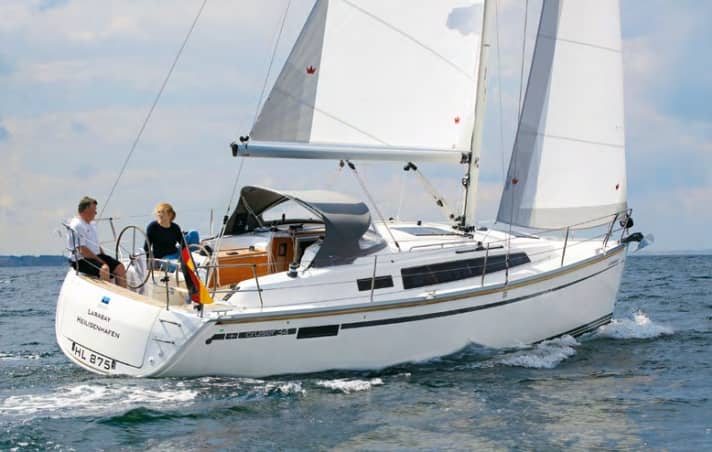
Bavaria Cruiser 34
The Farr design is the oldest competitor on the market, the hull is based on the Cruiser 32 from 2009. The boat is available with two or three cabins, but is quite narrow aft and in the cockpit.Hull length 9.99 m; width 3.42 m; weight 5.3 tonnes; from 136,612 euros
YACHT test: Issue 18/2016
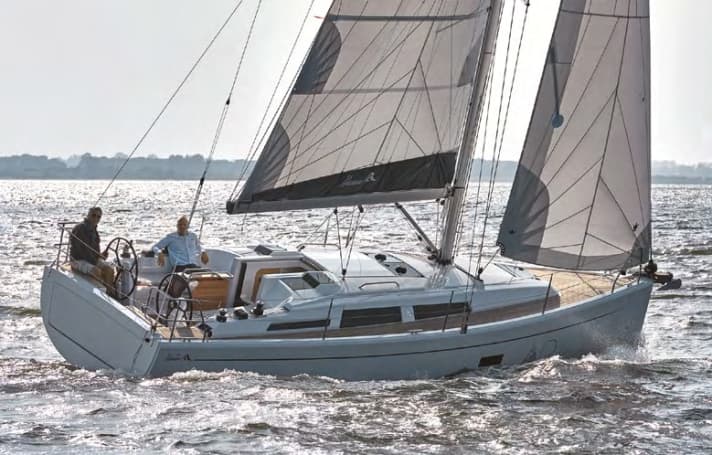
Hanse 348
The yacht from Greifswald impressed in the test with its good sailing characteristics and plenty of space. In the meantime, it no longer sets the standard in terms of space and variety.Hull length 9.99 m; width 3.50 m; weight 6.5 tonnes; from 164,101 euros
YACHT test: Issue 15/2018
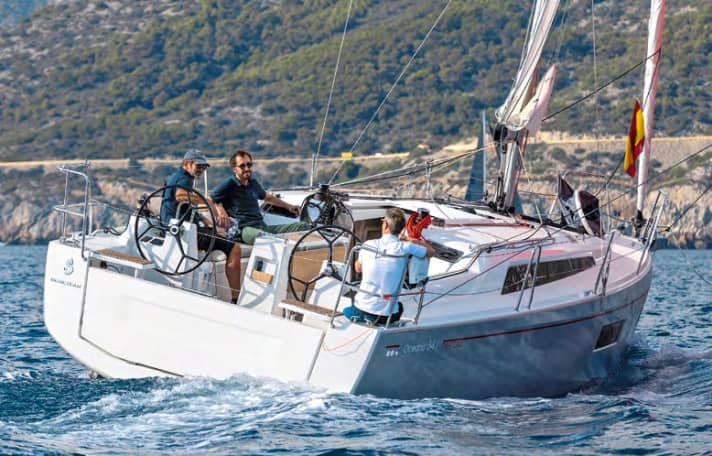
Oceanis 34.1
Last year, YACHT recognised the boat as having the largest volume in its class. This unique position is now a thing of the past. With a modern interior and good room layout, it is still contemporary.Hull length 9.96 m; width 3.57 m; weight 5.5 tonnes; from 142,681 euros
YACHT test: Issue 25-26/2021
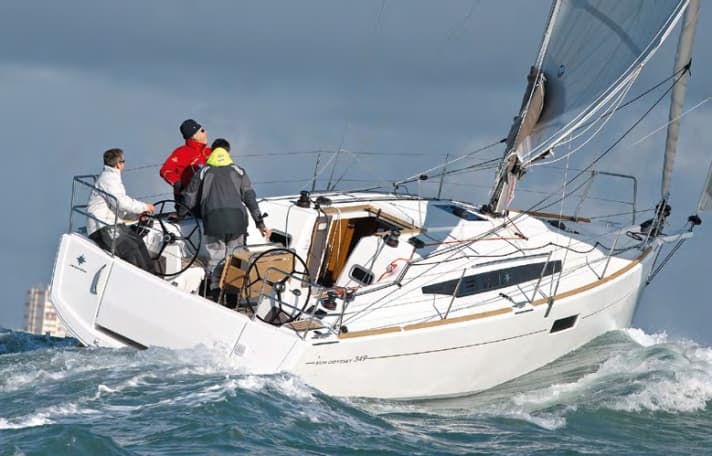
Sun Odyssey 349
Jeanneau's ten-metre yacht is entering its ninth year. This is noticeable below deck, where she offers less living space than the Dufour. However, she comes with a variable draught (swivelling keel) on request.Hull length 9.97 m; width 3.44 m; weight 5.3 tonnes; from 145,180 euros
YACHT test: Issue 6/2014
This might also interest you:

